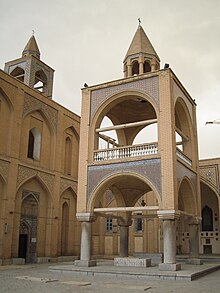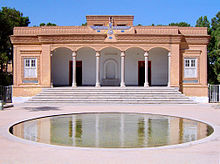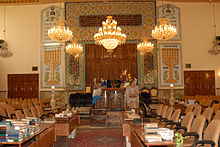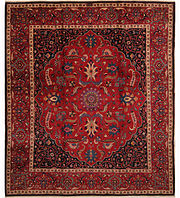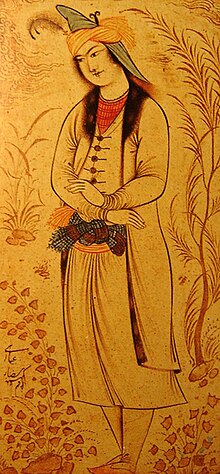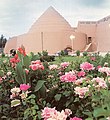According to the CIA World Factbook, around 90–95% of Iranians associate themselves with the Shia branch of Islam, the official state religion, and about 5–10% with the Sunni and Sufi branches of Islam. The remaining 0.6% associate themselves with non-Islamic religious minorities, including Bahá'ís, Mandeans, Yarsanis, Zoroastrians, Jews, and Christians. The latter three minority religions are officially recognized and protected, and have reserved seats in the Iran parliament. Zoroastrianism was once the majority religion, though today Zoroastrians number only in the tens of thousands. Iran is home to the second largest Jewish community in the Muslim World and the Middle East. The two largest non-Muslim religious minorities in Iran are the Bahá'í Faith and Christianity. The Bahá'í Faith, historically the largest religious minority in Iran, is not officially recognized, and has been persecuted during its existence in Iran.
Christianity, the largest non-Muslim minority religion that is
recognized by the Iranian government, has the largest annual growth rate
of all religions in Iran.
Islam
Ethnoreligious distribution in Iran
History
Islam has been the official religion and part of the governments of Iran since the Arab conquest of Iran circa 640 AD.[17] It took another few hundred years for Shia Islam to gather and become a religious and political power in Iran.[citation needed] In the history of Shia Islam the first Shia state was Idrisid dynasty (780–974) in Maghreb, a region of north west Africa. Then the Alavids dynasty (864 – 928AD) became established in Mazandaran (Tabaristan), in northern Iran. The Alavids were of the Zaidiyyah Shia (sometimes called "Fiver".)[18] These dynasties were local. But they were followed by two great and powerful dynasties: Fatimid Caliphate which formed in Ifriqiya in 909 AD and the Buyid dynasty emerged in Daylaman, in north central Iran, about 930 AD and then extended rule over central and western Iran and into Iraq until 1048 AD. The Buyid were also Zaidiyyah Shia. Later Sunni Islam came to rule from the Ghaznavids dynasty, 975 to 1187AD, through to the Mongol invasion and establishment of the Ilkhanate which kept Shia Islam out of power until the Mongol ruler Ghazan converted to Shia Islam in 1310 AD and made it the state religion.[19]Although Shias have lived in Iran since the earliest days of Islam, and there had been Shia dynasties in parts of Iran during the 10th and 11th centuries, according to Mortaza Motahhari the majority of Iranian scholars and masses remained Sunni till the time of the Safavids.[20]
However, there are four high points in the history of Shia in Iran that expanded this linkage:
- First, the migration of a number of persons belonging to the tribe of the Ash'ari from Iraq to the city of Qum towards the end of the 7th century AD, which is the period of establishment of Imami Shi‘ism in Iran.
- Second, the influence of the Shia tradition of Baghdad and Najaf on Iran during the 11th to 12th centuries AD.
- Third, the influence of the school of Hillah on Iran during the 14th century AD.
- Fourth, the influence of the Shi‘ism of Jabal Amel and Bahrain on Iran during the period of establishment of the Safavid rule.[21]
Thousands were killed in subsequent purges.[citation needed]In some cases entire towns were eliminated because they were not willing to convert from Sunni Islam to Shia Islam.[23] Ismail brought Arab Shia clerics from Bahrain, Iraq, Syria, and Lebanon in order to preach the Shia faith.[24] Ismail's attempt to spread Shia propaganda among the Turkmen tribes of eastern Anatolia prompted a conflict with the Sunnite Ottoman Empire. Following Iran's defeat by the Ottomans at the Battle of Chaldiran, Safavid expansion fasted, and a process of consolidation began in which Ismail sought to quell the more extreme expressions of faith among his followers.[25] While Ismail I declared shiism as the official state religion, it was in fact his successor, Tahmasb, who consolidated the Safavid rule and spread Shiʿism in Iran. After a period of indulgence in wine and the pleasures of the harem,[citation needed] he turned pious and parsimonious, observing all the Shiʿite rites and enforcing them as far as possible on his entourage and subjects.[23] Under Abbas I, Iran prospered. Succeeding Safavid rulers promoted Shi'a Islam among the elites, and it was only under Mullah Muhammad Baqir Majlisi – court cleric from 1680 until 1698- that Shia Islam truly took hold among the masses.[26]
Then there were successive dynasties in Iran – the Afsharid dynasty (1736–1796 AD) (which mixed Shi'a and Sunni), Zand dynasty (1750–1794 AD) (which was Twelver Shia Islam), the Qajar dynasty (1794–1925 AD) (again Twelver). There was a brief Iranian Constitutional Revolution in 1905–11 in which the progressive religious and liberal forces rebelled against theocratic rulers in government [27] who were also associated with European colonialization and their interests in the new Anglo-Persian Oil Company.The secularist efforts ultimately succeeded in the Pahlavi dynasty (1925–1979 AD). The 1953 Iranian coup d'état was orchestrated by Western powers[28] which created a backlash against Western powers in Iran, and was among the background and causes of the Iranian Revolution to the creation of the Islamic republic.
From the Islamization of Iran the cultural and religious expression of Iran participated in the Islamic Golden Age from the 9th through the 13th centuries AD, for 400 years.[29] This period was across Shia and Sunni dynasties through to the Mongol governance. Iran participated with its own scientists and scholars. Additionally the most important scholars of almost all of the Islamic sects and schools of thought were Persian or lived in Iran including most notable and reliable Hadith collectors of Shia and Sunni like Shaikh Saduq, Shaikh Kulainy, Muhammad al-Bukhari, Muslim ibn al-Hajjaj and Hakim al-Nishaburi, the greatest theologians of Shia and Sunni like Shaykh Tusi, Al-Ghazali, Fakhr al-Din al-Razi and Al-Zamakhshari, the greatest Islamic physicians, astronomers, logicians, mathematicians, metaphysicians, philosophers and scientists like Al-Farabi and Nasir al-Din al-Tusi, the Shaykhs of Sufism like Rumi, Abdul-Qadir Gilani – all these were in Iran or from Iran.[30] And there were poets like Hafiz who wrote extensively in religious themes. Ibn Sina, known as Avicenna in the west, was a polymath and the foremost Islamic physician and philosopher of his time.[31] Hafiz was the most celebrated Persian lyric poet and is often described as a poet's poet. Rumi's importance transcends national and ethnic borders even today.[32] Readers of the Persian and Turkish language in Iran, Azerbaijan, Turkey, Afghanistan, Tajikistan and Uzbekistan see him as one of their most significant classical poets and an influence on many poets through history.[33] In addition to individuals, whole institutions arose – Nizamiyyas were the medieval institutions of Islamic higher education established by Nizam al-Mulk in the 11th century. These were the first well-organized universities in the Muslim world. The most famous and celebrated of all the nizamiyyah schools was Al-Nizamiyya of Baghdad (established 1065), where Nizam al-Mulk appointed the distinguished philosopher and theologian, al-Ghazali, as a professor. Other Nizamiyyah schools were located in Nishapur, Balkh, Herat, and Isfahan.
While the dynasties avowed either Shia or Sunni, and institutions and individuals claimed either Sunni or Shia affiliations, Shia – Sunni relations were part of Islam in Iran and continue today when Ayatollah Khomeini also called for unity between Sunni and Shia Muslims.
Shi'a Islam
A Shia Mosque in Tehran
Today Islam is the religion of 99.6% of Iranians of which approximately 89% are Shia – almost all of whom are Twelvers.[34] The Shia groups have distinctions between Fiver, Sevener and Twelver, derived from their belief in how many divinely ordained leaders there were who are descendants of the Islamic prophet Muhammad through his daughter Fatimah and his son-in-law Ali. These Imams are considered the best source of knowledge about the Quran and Islam, the most trusted carriers and protectors of Muḥammad's Sunnah (habit or usual practice) and the most worthy of emulation. In addition to the lineage of Imams, Twelvers have their preferred hadith collections – The Four Books – which are narrations regarded by Muslims as important tools for understanding the Quran and in matters of jurisprudence. For Twelvers the lineage of Imams are known as the Twelve Imams. Of these Imams, only one is buried in Iran – at the Imam Reza shrine, for Ali ar-Ridha who lived from 765 – 818 AD, before any Shi'a dynasties arose in Iran. The last Imam recognized by Twelvers, Muhammad al-Mahdi, was born in 868 AD as the Alavids spread their rule in Iran while in conflict with Al-Mu'tamid, the Abbasid Caliph at the time. Several Imams are buried in Iraq, as sites of pilgrimage, and the rest are in Saudi Arabia. In addition two of the Five Martyrs of Shia Islam have connections to Iran – Shahid Thani (1506–1558) lived in Iran later in life, and Qazi Nurullah Shustari (1549–1610) was born in Iran. The predominant school of theology, practice, and jurisprudence (Madh'hab) in Shia Islam is Jafari established by Ja'far as-Sadiq.[35]
Sunni Islam
Sunni Muslims are the second largest religious group in Iran.[36] Specifically, Sunni Islam came to rule in Iran after the period Sunni were distinguished from Shi'a through the Ghaznavids from 975 AD, followed by the Great Seljuq Empire and the Khwarazm-Shah dynasty until the Mongol invasion of Iran. Sunni Islam returned to rule when Ghazan converted.About 9%[1] of the Iranian population are Sunni Muslims—mostly Larestani people (Khodmooni) from Larestan, Kurds in the northwest, Arabs and Balochs in the southwest and southeast, and a smaller number of Persians, Pashtuns and Turkmens in the northeast.
Sunni websites and organizations complain about the absence of any official records regarding their community and believe their number is much greater than what is usually estimated. Demographic changes have become an issue for both sides. Scholars on either side speak about the increase in the Sunni population and usually issue predictions regarding demographic changes in the country. One prediction, for example, claims that the Sunnis will be the majority in Iran by 2030.[37]
The mountainous region of Larestan is mostly inhabited by indigenous Sunni Persians who did not convert to Shia Islam during the Safavids because the mountainous region of Larestan was too isolated. The majority of Larestani people are Sunni Muslims,[38][39][40] 30% of Larestani people are Shia Muslims. The people of Larestan speak the Lari language, which is a southwestern Iranian language closely related to Old Persian (pre-Islamic Persian) and Luri.[41] Sunni Larestani Iranians migrated to the Arab states of the Persian Gulf in large numbers in the late 19th century. Some Sunni Emirati, Bahraini and Kuwaiti citizens are of Larestani ancestry.
Iran's Ministry of Health announced that all family-planning programs and procedures would be suspended. Supreme Leader Ayatollah Ali Khamenei called on women to have more children to boost the country's population to 150–200 million. Contraceptive policy made sense 20 years ago, he said, but its continuation in later years was wrong. Numerous speculations have been given for this change in policy: that it was an attempt to show the world that Iran is not suffering from sanctions; to avoid an aging population with rising medical and social-security costs; or to return to Iran's genuine culture. Some speculate that the new policy seeks to address the Supreme Leader's concerns that Iran's Sunni population is growing much faster than its Shia one (7% growth in Sunni areas compared to 1–1.3% in Shia areas).[42][43]
The predominant school of theology and jurisprudence (Madh'hab) among Sunnis in Iran is Hanafi, established by Abu Hanifa.
According to Mehdi Khalaji, Salafi Islamic thoughts have been on the rise in Iran in recent years. Salafism alongside extremist Ghulat Shia sects has become popular amongst some Iranian youth, who connect through social media and underground organizations. The Iranian government views Salafism as a threat and does not allow Salafis to build mosques in Tehran or other large cities due to the fear that these mosques could be infiltrated by extremists.[44]
It is allegedly reported that members of religious minorities, especially Sunni Muslims who supported rebels in Syrian Civil War, are increasingly persecuted by authorities. The government imprisons, harasses and discriminates people because of their religious beliefs.[45]
Sufism
The Safaviya sufi order, originates during the circa Safavid dynasty circa 700AD. A later order in Persia is the Chishti. The Nimatullahi are the largest Shi'i Sufi order active throughout Iran and there is the Naqshbandi, a Sunni order active mostly in the Kurdish regions of Iran. The Oveyssi-Shahmaghsoudi order is the largest Iranian Sufi order which currently operates outside of Iran.Famous Sufis include al-Farabi, al-Ghazali, Rumi, and Hafiz. Rumi's two major works, Diwan-e Shams and Masnavi, are considered by some to be the greatest works of Sufi mysticism and literature.
Since the 1979 Revolution, Sufi practices have been repressed by the Islamic Republic, forcing some Sufi leaders into exile.[46][47]
While no official statistics are available for Sufi groups, there are reports that estimate their population between two and five million (between 3–7% of the population).[36]
Other religions
There are several major religious minorities in Iran, Bahá'ís (est. 300,000–350,000)[4][48][49] and Christians (est. 300,000[50] – 370,000[50] with one group, the Armenians of the Armenian Apostolic Church, composing between 200,000 and 300,000[51][52]) being the largest. Smaller groups include Jews, Zoroastrians, Mandaeans, and Yarsan, as well as local religions practiced by tribal minorities.[36][53]Zoroastrians, Jews, and Christians are officially recognized and protected by the government. For example, shortly after his return from exile in 1979, at a time of great unrest, the revolution's leader, Ayatollah Ruhollah Khomeini issued a fatwa ordering that Jews and other minorities be treated well.[54][55]
Contemporary status
The constitution of the Islamic Republic of Iran recognizes Islam, Christianity, Judaism, and Zoroastrianism as official religions. Article 13 of the Iranian Constitution, recognizes them as People of the Book and they are granted the right to exercise religious freedom in Iran.[48][56] Five of the 270 seats in parliament are reserved for these each of these three religions.In 2017 there has been a controversy around the reelection of a Zoroastrian municipal councillor in Yazd, as there was no clear legislation on the matter. "On April 15, about one month before Iran’s local and presidential elections", Ahmad Jannati, head of the Guardian Council, had "issued a directive demanding that non-Muslims be disqualified from running in the then-upcoming city and village council elections in localities where most of the population are Muslims".[57] On November 26, 2017, Iranian lawmakers approved the urgency of a bill that would give the right for members of the religious minorities to nominate candidates for the city and village councils elections. The bill secured 154 yes votes, 23 no and 10 abstention. A total of 204 lawmakers were present at the parliament session.[58]
On the other hand, senior government posts are reserved for Muslims. All minority religious groups, including Sunni Muslims, are barred from being elected president. Jewish, Christian and Zoroastrian schools must be run by Muslim principals.[59] Compensation for death paid to the family of a non-Muslim was (by law) less than if the victim was a Muslim until recently. Conversion to Islam is encouraged by islamic inheritance laws, which mean that by converting to Islam, a convert will inherit the entire share of their parents' (or even uncle's) estate if their siblings (or cousins) remain non-Muslim.[60] Iran's non-Muslim population has fallen dramatically. For example, the Jewish population in Iran dropped from 80,000 to 30,000 in the first two decades of the revolution.[61] By 2012, it had dwindled below 9,000.[62]
Irreligion
According to Moaddel and Azadarmaki (2003), fewer than 5% of Iranians do not believe in God.[63] A 2009 Gallup poll showed that 83% of Iranians said religion is an important part of their daily life.[64] Non-religious Iranians are officially unrecognized by the government. The irreligiosity figures in the diaspora are higher, notably among Iranian-Americans.[65][66]Bahá'í Faith
The Bahá'í Faith, has been persecuted during its existence in Iran.[8][9][10][67][68] Since the 1979 revolution the persecution of Bahá'ís has increased with oppression, the denial of civil rights and liberties, and the denial of access to higher education and employment.[8][69][67][68][70] There were an estimated 350,000 Bahá'ís in Iran in 1986.[69] The Bahá'ís are scattered in small communities throughout Iran with a heavy concentration in Tehran. Most Bahá'ís are urban, but there are some Bahá'í villages, especially in Fars and Mazandaran. The majority of Bahá'ís are Persians, but there is a significant minority of Azeri Bahá'ís, and there are even a few among the Kurds. Bahá'ís are neither recognized nor protected by the Iranian constitution.The Bahá'í Faith originated in Iran during the 1840s as a messianic movement out of Shia Islam. Opposition arose quickly, and Amir Kabir, as prime-minister, regarded the Bábis as a threat and ordered the execution of the founder of the movement, the Báb and killing of as many as 2,000 to 3,000 Babis.[71] As another example two prominent Bahá'ís were arrested and executed circa 1880 because the Imám-Jum'ih at the time owed them a large sum of money for business relations and instead of paying them he confiscated their property and brought public ridicule upon them as being Bahá'ís.[72] Their execution was committed despite observers testifying to their innocence.
The Shia clergy, as well as many Iranians, have continued to regard Bahá'ís as heretics, and consequently Bahá'ís have encountered much prejudice and have sometimes been the objects of persecution. The situation of the Bahá'ís improved under the Pahlavi shahs when the government actively sought to secularize public life however there were still organizations actively persecuting the Bahá'ís in addition to there being curses children would learn decrying the Báb and Bahá'ís.[73] The Hojjatieh was a semi-clandestine traditionalist Shia organization founded by Muslim clerics[73] on the premise that the most immediate threat to Islam was the Bahá'í Faith.[74] In March to June 1955, the Ramadan period that year, a widespread systematic program was undertaken cooperatively by the government and the clergy. During the period they destroyed the national Bahá'í Center in Tehran, confiscated properties and made it illegal for a time to be Bahá'í (punishable by 2 to 10-year prison term.)[75] Founder of SAVAK, Teymur Bakhtiar, took a pick-ax to a Bahá'í building himself at the time.[76]
The social situation of the Bahá'ís was drastically altered after the 1979 revolution. The Hojjatieh group flourished during the 1979 revolution but was forced to dissolve after Ayatollah Ruhollah Khomeini speech on 12 August 1983. However, there are signs of it reforming circa 2002-4.[76] Beyond the Hojjatieh group, the Islamic Republic does not recognize the Bahá'ís as a religious minority, and they have been officially persecuted, "some 200 of whom have been executed and the rest forced to convert or subjected to the most horrendous disabilities." [77] Starting in late 1979 the new government systematically targeted the leadership of the Bahá'í community by focusing on the Bahá'í National Spiritual Assembly (NSA) and Local Spiritual Assemblies (LSAs); prominent members of NSAs and LSAs were either killed or disappeared.[69] Like most conservative Muslims, Khomeini believed them to be apostates, for example issuing a fatwa stating:
It is not acceptable that a tributary [non-Muslim who pays tribute] changes his religion to another religion not recognized by the followers of the previous religion. For example, from the Jews who become Bahai's nothing is accepted except Islam or execution.[78]and emphasized that the Bahá'ís would not receive any religious rights, since he believed that the Bahá'ís were a political rather than religious movement.[79][80]
the Baha'is are not a sect but a party, which was previously supported by Britain and now the United States. The Baha'is are also spies just like the Tudeh [Communist Party].[81]This is all despite the fact that conversion from Judaism and Zoroastrianism in Iran is well documented since the 1850s – indeed such a change of status removing legal and social protections.
Allegations of Bahá'í involvement with other powers have long been repeated in many venues including denunciations from the president.[87][88]
During the drafting of the new constitution the wording intentionally excluded the Bahá'ís from protection as a religious minority.[89] More recently, documentation has been provided that shows governmental intent to destroy the Bahá'í community. The government has intensified propaganda and hate speech against Bahá'ís through the Iranian media; Bahá'ís are often attacked and dehumanized on political, religious, and social grounds to separate Bahá'ís from the rest of society.[90] According to Eliz Sanasarian "Of all non-Muslim religious minorities the persecution of the Bahais has been the most widespread, systematic, and uninterrupted.… In contrast to other non-Muslim minorities, the Bahais have been spread throughout the country in villages, small towns, and various cities, fueling the paranoia of the prejudiced."[87]
Since the 1979 revolution, the authorities have destroyed most or all of the Baha'i holy places in Iran, including the House of the Bab in Shiraz, a house in Tehran where Bahá'u'lláh was brought up, and other sites connected to aspects of Babi and Baha'i history. These demolitions have sometimes been followed by the construction of mosques in a deliberate act of triumphalism. Many or all of the Baha'i cemeteries in Iran have been demolished and corpses exhumed. Indeed, several agencies and experts and journals have published concerns about viewing the developments as a case of genocide: Roméo Dallaire,[91][92] Genocide Watch,[93] Sentinel Project for Genocide Prevention,[94] War Crimes, Genocide, & Crimes against Humanity[95] and the Journal of Genocide Research.[96]
Mandaeism
The number of Iranian Mandaeans is a matter of dispute. In 2009, there were an estimated 5,000 and 10,000 Mandaeans in Iran, according to the Associated Press,[97] while Alarabiya has put the number of Iranian Mandaeans as high as 60,000 in 2011.[98]Until the Iranian Revolution, Mandaeans had mainly been concentrated in Khuzestan province, where the community historically existed side by side with the local Arab population. They had mainly practiced the profession of goldsmith, passing it from generation to generation.[98] After the fall of the shah, its members faced increased religious discrimination, and many sought new homes in Europe and the Americas.
In 2002 the US State Department granted Iranian Mandaeans protective refugee status; since then roughly 1,000 have emigrated to the US,[97] now residing in cities such as San Antonio, Texas.[99] On the other hand, the Mandaean community in Iran has increased in size over the last decade, because of the exodus from Iraq of the main Mandaean community, which once was 60,000–70,000 strong.
Christianity
Christianity in Iran has had a long history, dating back to the very early years of the faith. And the region is thought to have affected Christianity as well with perhaps the introduction of the concept of The Devil.[100] There are some very old churches in Iran – perhaps the oldest and largest is the St. Thaddeus Monastery, which is also called the Ghara Kelissa (the Black Monastery), south of Maku.[101] By far the largest group of Christians in Iran are Armenians under the Armenian Apostolic Church which has between 110,000,[102] 250,000,[103] and 300,000 adherents.[51] There are many hundreds of Christian churches in Iran, with at least 600 being active serving the nation its Christian population.[104][105] The Armenian church is currently as of early 2015 organized under Sepuh Sargsyan, who has succeeded Archbishop Manukian, the Armenian Apostolic Archbishop since at least the 1980s.[52][87][106] Unofficial estimates for the Assyrian Christian population range between 20,000,[107][108] and 70,000.[109][110] Christian groups outside the country estimate the size of the Protestant Christian community to be fewer than 10,000, although many may practice in secret.[36] There are approximately 20,000 Christians Iranian citizens abroad who left after the 1979 revolution.[111] Christianity has always been a minority religion, overshadowed by the majority state religions—Zoroastrianism in the past, and Shia Islam today. Christians of Iran have played a significant part in the history of Christian mission. While always a minority the Armenian Christians have had an autonomy of educational institutions such as the use of their language in schools.[87] The Government regards the Mandaeans as Christians, and they are included among the three recognized religious minorities; however, Mandaeans do not consider themselves Christians.[36]
Christian population estimations range between 300,000[50] and 370,000[50] adherents; one estimate suggests a range between 100,000 and 500,000 Christian believers from a Muslim background living in Iran, most of them evangelical Christians.[112] Of the three non-Muslim religions recognized by the Iranian government, the 2011 General Census indicated that Christianity was the largest in the nation.[113]
The small evangelical Protestants Christian minority in Iran have been subject to Islamic "government suspicion and hostility" according to Human Rights Watch at least in part because of their "readiness to accept and even seek out Muslim converts" as well as their Western origins. According to Human Rights Watch in the 1990s, two Muslim converts to Christianity who had become ministers were sentenced to death for apostasy and other charges.[114] There still have not been any reported executions of apostates. However many people, such as Youcef Nadarkhani, Saeed Abedini have been recently harassed, jailed and sentenced to death for Apostasy. As of 2017, there are over 3 million Christians in Iran.[115]
Yarsanism
The Yarsan or Ahl-e Haqq is a syncretic religion founded by Sultan Sahak in the late 14th century in western Iran.[116] The total number of members is estimated at around 1,000,000 in 2004,[117] primarily found in western Iran and Iraq, mostly ethnic Goran Kurds,[118][119][120] though there are also smaller groups of Persian, Lori, Azeri and Arab adherents.[121] Some Yarsanis are also present in southeastern Turkey.Zoroastrianism
Zoroastrian Fire Temple in Yazd
Zoroastrians in Iran have had a long history reaching back thousands of years, and are the oldest religious community of Iran that has survived to the present day. Prior to the Muslim Arab invasion of Persia (Iran), Zoroastrianism had been the primary religion of Iranian people. Zoroastrians mainly are ethnic Persians and are concentrated in the cities of Tehran, Kerman, and Yazd. The Islamic Republic government estimates the number of Zoroastrians is 20,000, Zoroastrian groups in Iran say their number is approximately 60,000.[4] According to the Iranian census data from 2011 the number of Zoroastrians in Iran was 25,271.[122]
Since the fall of the Sassanid Zoroastrian empire by the Arab conquest of Persia, in different periods of post-Islamic history of Iran, Zoroastrians have periodically faced extreme religious oppression including forced conversions, massacres, harassment, and other forms of discrimination.
This oppression has led to a massive diaspora community across the world, in particular the Parsis of India, who number significantly higher than the Zoroastrians in Iran.
Judaism
YusefAbad synagogue in Tehran
Judaism is one of the oldest religions practiced in Iran and dates back to the late biblical times. The biblical books of Isaiah, Daniel, Ezra, Nehemiah, Chronicles, and Esther contain references to the life and experiences of Jews in Persia.
Iran supports by far the largest Jewish population of any Muslim country.[54] In recent decades, the Jewish population of Iran has been reported by some sources to be 25,000,[123][124][125] though estimates vary, as low as 11,000 [126] and as high as 40,000.[127] According to the Iranian census data from 2011 the number of Jews in Iran was 8,756, much lower than the figure previously estimated.[122]
Emigration has lowered the population of 75,000 to 80,000 Jews living in Iran prior to the 1979 Islamic revolution.[4] According to The world Jewish Library, most Jews in Iran live in Tehran, Isfahan (3,000), and Shiraz. BBC reported Yazd is home to ten Jewish families, six of them related by marriage, however some estimate the number is much higher. Historically, Jews maintained a presence in many more Iranian cities.
Today, the largest groups of Jews from Iran are found in the United States which is home to approximately 100,000 Iranian Jews, who have settled especially in the Los Angeles area and New York City area.[128] Israel is home to 75,000 Iranian Jews, including second-generation Israelis.[129]
Hinduism
A.C. Bhaktivedanta Swami Prabhupada traveled to Tehran in 1976.[130] Since 1977, ISKCON runs a vegetarian restaurant in Tehran.[131]Historical religions
Religious freedom
Iran is an Islamic republic. Its constitution mandates that the official religion is Islam (see: Islam in Iran), specifically the Twelver Ja'fari school of Islam, with other Islamic schools being accorded full respect. Followers of all Islamic schools are free to act in accordance with their own jurisprudence in performing their religious rites. The constitution recognizes Zoroastrian, Jewish, and Christian Iranians as religious minorities.While several religious minorities lack equal rights with Muslims, complaints about religious freedom largely revolve around the persecution of the Bahá'í Faith, the country's largest religious minority, which faces active persecution.[70] Several important Bahá'í cemeteries and holy places have been demolished, and there have been reports of imprisonment, harassment, intimidation, discrimination, and murder based on religious beliefs.[132]
Hudud statutes grant different punishments to Muslims and non-Muslims for the same crime. In the case of adultery, for example, a Muslim man who is convicted of committing adultery with a Muslim woman receives 100 lashes; the sentence for a non-Muslim man convicted of adultery with a Muslim woman is death.[133] In 2004, inequality of "blood money" (diya) was eliminated, and the amount paid by a perpetrator for the death or wounding a Christian, Jew, or Zoroastrian man, was made the same as that for a Muslim. However, the International Religious Freedom Report reports that Baha'is were not included in the provision and their blood is considered Mobah, (i.e. it can be spilled with impunity).[4]
Conversion from Islam to another religion (apostasy), is prohibited and may be punishable by death. Article 23 of the constitution states, "the investigation of individuals' beliefs is forbidden, and no one may be molested or taken to task simply for holding a certain belief." But another article, 167, gives judges the discretion "to deliver his judgment on the basis of authoritative Islamic sources and authentic fatwa (rulings issued by qualified clerical jurists)." The founder of the Islamic Republic, Islamic cleric Ruhollah Khomeini, who was a grand Ayatollah, ruled "that the penalty for conversion from Islam, or apostasy, is death."[134]
At least two Iranians – Hashem Aghajari and Hassan Yousefi Eshkevari – have been arrested and charged with apostasy (though not executed), not for converting to another faith but for statements and/or activities deemed by courts of the Islamic Republic to be in violation of Islam, and that appear to outsiders to be Islamic reformist political expression.[135] Hashem Aghajari, was found guilty of apostasy for a speech urging Iranians to "not blindly follow" Islamic clerics;[136] Hassan Youssefi Eshkevari was charged with apostasy for attending the 'Iran After the Elections' Conference in Berlin Germany which was disrupted by anti-government demonstrators.




